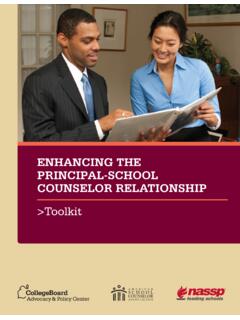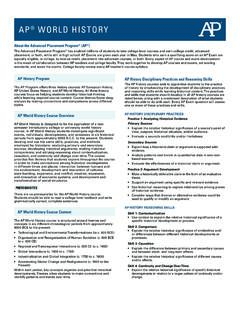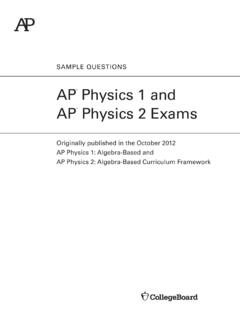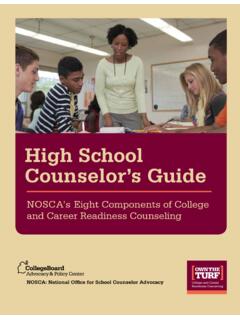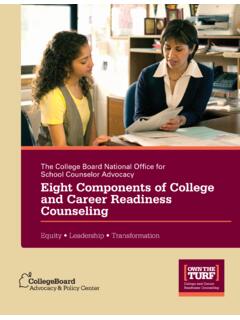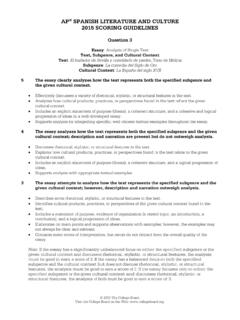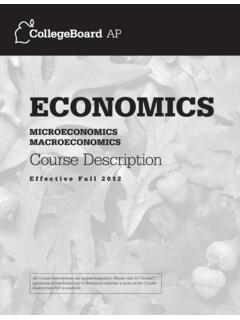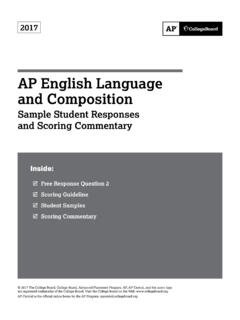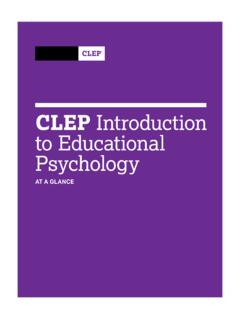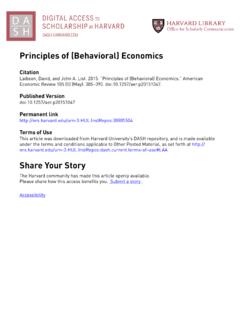Transcription of STANDARDS FOR FOREIGN LANGUAGE LEARNING
1 STANDARDSFORFOREIGNLANGUAGELEARNINGP reparing for the 21st CenturyCOMMUNITIESCONNECTIONSCOMMUNICATI ONCOMPARISONSCULTURESIn 1993, a coalition offour national LANGUAGE organi-zations (the AmericanCouncil on the Teaching ofForeign Languages, theAmerican Association ofTeachers of French, theAmerican Association ofTeachers of German, andthe American Association ofTeachers of Spanish andPortuguese) received fund-ing to develop standardsfor FOREIGN LANGUAGE educa-tion, grades K-12. This was the seventhand final subject area toreceive federal support todevelop national standardsas part of the Bush Admini-stration s America 2000education initiative, whichcontinued under Goals 2000 in the Clinton Administration. An eleven-member taskforce, representing a variety of languages, levels of instruction, program models, andgeographic regions, was appointed to undertake the task of defining content stan-dards what students should know and be able to do in FOREIGN LANGUAGE each stage of development, the task force shared its work with the broader profes-sion and the public at large.
2 The resulting document represents an unprecedentedconsensus among educators, business leaders, government, and the community on thedefinition and role of FOREIGN LANGUAGE instruction in American STANDARDS do not describe the current status of FOREIGN LANGUAGE education inthis country. While they reflect the best instructional practice, they do not describewhat is being attained by the majority of FOREIGN LANGUAGE students. The STANDARDS forForeign LANGUAGE Learningwill not be achieved overnight; rather, they provide a gaugeagainst which to measure improvement in the years to come. The STANDARDS are not a curriculum guide. While they suggest the types of curric-ular experiences needed to enable students to achieve the STANDARDS , and support theideal of extended sequences of study that begin in the elementary grades and contin-ue through high school and beyond, they do not describe specific course content, norrecommended sequence of study.
3 They must be used in conjunction with state andlocal STANDARDS and curriculum frameworks to determine the best approaches and rea-sonable expectations for the students in individual districts and and communication are at theheart of the human experience. TheUnited States must educate students whoare linguistically and culturally equippedto communicate successfully in a plural-istic American society and abroad. Thisimperative envisions a future in whichALL students will develop and maintainproficiency in English and at least oneother LANGUAGE , modern or who come to school from non-English backgrounds should also haveopportunities to develop further profi-ciencies in their first of PhilosophyStandards for FOREIGN LANGUAGE LearningThe purposes and uses of FOREIGN languages are as diverse as thestudents who study them. Some students study another LANGUAGE inhopes of finding a rewarding career in the international marketplaceor government service.
4 Others are interested in the intellectual chal-lenge and cognitive benefits that accrue to those who master multi-ple languages. Still others seek greater understanding of other peo-ple and other cultures. Many approach FOREIGN LANGUAGE study, asthey do other courses, simply to fulfill a graduation of the reason for study, FOREIGN languages have some-thing to offer everyone. It is with this philosophy in mind that thestandards task force identified five goal areas that encompass all ofthese reasons: Communication, Cultures, Connections, Compari-sons, andCommunities the five C s of FOREIGN LANGUAGE at the heart of second LANGUAGE study,whether the communication takes place face-to-face, in writing,or across centuries through the reading of literature. Through the study of other languages, students gain aknowledge and understanding of the culturesthat use that lan-guage and, in fact, cannot truly master the LANGUAGE until theyhave also mastered the cultural contexts in which the languages provides connectionsto additional bod-ies of knowledge that may be unavailable to the monolingualEnglish speaker.
5 Through comparisonsand contrasts with the languagebeing studied, students develop insight into the nature of lan-guage and the concept of culture and realize that there are mul-tiple ways of viewing the world. Together, these elements enable the student of languages toparticipate in multilingual communitiesat home and aroundthe world in a variety of contexts and in culturally appropriateways. Knowing how, when, and why to say what to whom All the linguistic and social knowledge required for effective human-to-human inter-action is encompassed in those ten words. Formerly, most teaching in FOREIGN lan-guage classrooms concentrated on the how(grammar) to say what(vocabulary).While these components of LANGUAGE are indeed crucial, the current organizing princi-ple for FOREIGN LANGUAGE study is communication, which also highlights the why, thewhom, and the when.
6 So, while grammar and vocabulary are essential tools for com-munication, it is the acquisition of the ability to communicate in meaningful andappropriate ways with users of other languages that is the ultimate goal of today s for-eign LANGUAGE Five C s ofForeign LanguageEducationCommunicationCulturesCo nnectionsComparisonsCommunitiesStandards forForeignLanguageLearningCommunicationC ommunicate in LanguagesOther Than EnglishStandard :Students engage in conversa-tions, provide and obtain information,express feelings and emotions, and :Students understand andinterpret written and spoken LANGUAGE ona variety of :Students present informa-tion, concepts, and ideas to an audience oflisteners or readers on a variety of Knowledge andUnderstanding of Other CulturesStandard :Students demonstrate anunderstanding of the relationship betweenthe practices and perspectives of the cul-ture : Students demonstrate anunderstanding of the relationship betweenthe products and perspectives of the cul-ture with Other Disciplines andAcquire InformationStandard :Students reinforce and fur-ther their knowledge of other disciplinesthrough the FOREIGN :Students acquire informationand recognize the distinctive viewpointsthat are only available through the foreignlanguage and its Insight into the Nature ofLanguage and CultureStandard :Students demonstrate under-standing of the nature of LANGUAGE through com-parisons of the LANGUAGE studied and their.
7 Students demonstrate under-standing of the concept of culture through com-parisons of the cultures studied and their in Multilingual Communitiesat Home & Around the WorldStandard :Students use the languageboth within and beyond the school :Students show evidence ofbecoming life-long learners by using thelanguage for personal enjoyment is an abbreviated sample of the goals, STANDARDS , and progress indicators for grades four, eight, and twelveas they appear in STANDARDS for FOREIGN LANGUAGE LEARNING : Preparing for the 21st Century. Students engage in conversations, provide and obtain information, express feelings and emotions,and exchange standard focuses on interpersonal communication, that is, direct oral or written communi-cation between individuals who are in personal contact. In most modern languages, studentscan quite quickly learn a number of phrases that will permit them to interact with each the course of their study, they will grow in their ability to converse in a culturally appropri-ate manner.
8 Sample Progress understand and interpret written and spoken LANGUAGE on a variety of involves one-way listening and reading in which the learner works with a varietyof print and non-print materials. The context in which the LANGUAGE is experienced and the abil-ity to control what they hear and read may impact students development of comprehension. Asa result, the ability to read may develop before the ability to comprehend rapid spoken addition, content knowledge will often affect successful comprehension, for students under-stand more easily materials that reflect their interests or for which they have some Progress present information, concepts, and ideas to an audience of listeners or readers on a variety of standard focuses on the formal presentation of information, concepts, and ideas in spokenand written form and is concerned, in most cases, with one-way speaking and writing.
9 Studentswith little or no previous LANGUAGE experience are likely to produce written and spoken lan-guage that will contain a variety of learned patterns or will look like English with words in theother LANGUAGE . This is a natural process and, over time, they begin to acquire authentic patternsand to use appropriate styles. By contrast, home-background students will write in ways thatclosely resemble the spoken LANGUAGE . Moreover, they will control informal oral styles. Overtime these learners will develop the ability to write and speak using more formal Progress IndicatorsGrade 4: Students ask and answer ques-tions about such things as family, schoolevents, and celebrations in person or vialetters, e-mail, or audio and video 8: Students exchange informationabout personal events, memorable experi-ences, and other school subjects with peersand/or members of the target 12: Students exchange, support, anddiscuss their opinions and individual perspec-tives with peers and/or speakers of the targetlanguage on a variety of topics dealing withcontemporary and historical 4: Students comprehend the mainidea of developmentally appropriate oralnarratives such as personal anecdotes, famil-iar fairy tales, and other narratives based onfamiliar 8.
10 Students use knowledge acquired inother settings and from other subject areas tocomprehend spoken andwritten messagesin the target 12: Students demonstrate an increasingunderstanding of the cultural nuances ofmeaning in written and spoken LANGUAGE asexpressed by speakers and writers of the targetlanguage in formaland informal 4: Students prepare illustrated sto-ries about activities or events in their envi-ronment and share with an audience suchas the 8: Students prepare tape or videorecorded messages to share locally or withschool peers and/or members of the targetcultures on topics of personal 12: Students prepare a research-based analysis of a current event from theperspective of both the and target demonstrate an understanding of therelationship between the practices and per-spectives of the culture standard focuses on the practi cesthat arederived fr om the traditional ideas and attitudes (per-spectives) of a culture.
